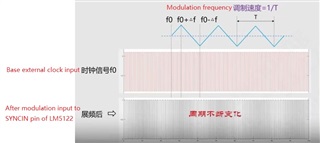Other Parts Discussed in Thread: LM5122
Hi Team,
Our customer is using LM5122-Q1 in dual phase configuration, in order to improve EMI performance, they want to check if we can use one external sync clock with spread spectrum feature feed into SYNC pin as below. Can you help to check this design if any issues? Any considerations should be paid attention to?

Thanks.


